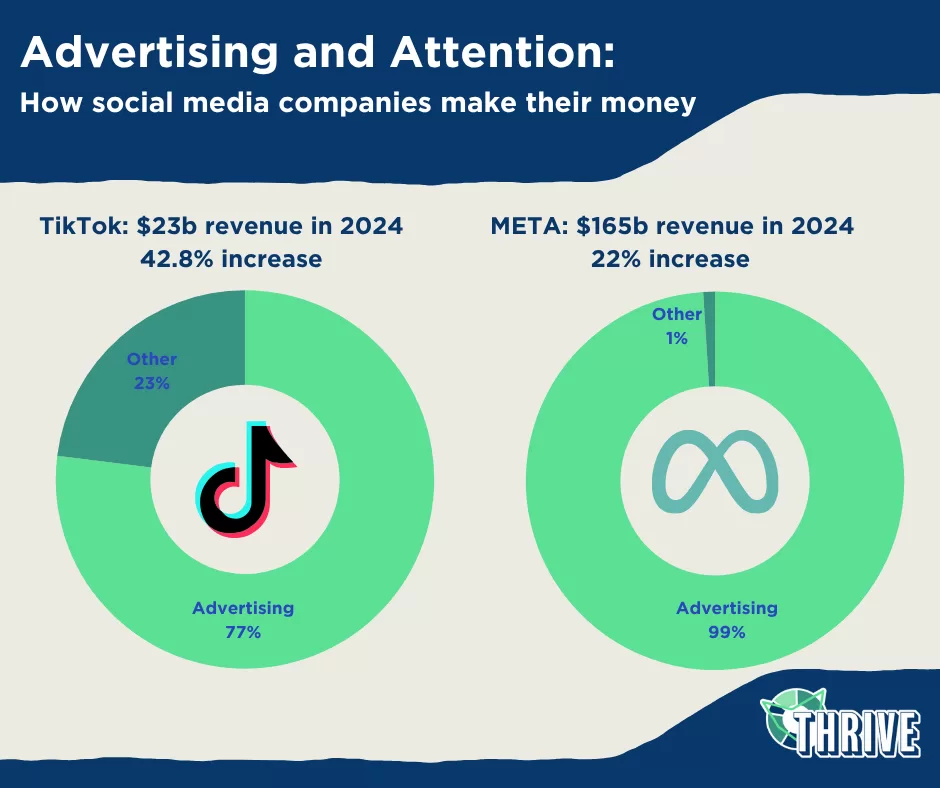INTRODUCTION: SCREENWASHING AND DIGITAL WELLNESS
It certainly isn’t a stretch to say that social media platforms, namely TikTok, Instagram, and Facebook, are almost solely responsible for a concerningly large array of ethical issues (Bhargava et al., 2021). Social media usage has been consistently linked to declining mental health, a collective decrease in attention span and cognitive function, increased political polarisation and radicalisation, widespread misinformation, and a plethora of other negative outcomes well-documented in current academic and clinical research (Bhargava et al., 2021, Bossen et al., 2020, Muhammed et al., 2022). As society grapples with the psychosocial impacts of pervasive screen use, tech companies are quick to offer solutions. However, this creates a further dilemma: that of screenwashing. Can we really trust the same companies that have created these issues to also remedy them?
Social media platforms want you, the user, to believe they are enacting genuine change. Growing public concern about the regulation of social media has prompted platforms to adopt measures aimed at fostering a sense of user comfort and agency (Koning et al., 2024). Yet, it is difficult to argue that these platforms are providing solutions beyond the cosmetic and performative, even when we interpret their actions and statements generously. Instead, we are being lulled into a false sense of security. Social media continues to function as it always has. This is ‘screenwashing’: the strategic use of well-being rhetoric and features by digital platforms to deflect criticism, even though core engagement-driven designs remain largely unchanged (Koning et al., 2024).
So, how do we recognise screenwashing? What are the social, political, and economic factors at play here? And, most importantly, how do we protect our well-being when faced with it?

A snapshot of our tech addiction.
Source: Unsplash, n.d.
SCREENWASHING: A NEW FORM OF DIGITAL DECEPTION
The term ‘screenwashing’ draws a clear parallel to ‘greenwashing’: both refer to the intentional misleading of consumers through the selective sharing of positive information about a business. In the case of greenwashing, companies create a false impression of environmental responsibility. This is not supported by their actual practices, performance, or metrics, aiming to maintain a reputable brand identity (De Freitas Netto et al., 2020). Digital platforms culpable for screenwashing follow a similar method, purposefully leading users to believe that their platforms are genuinely and positively invested in collective well-being, even though their business models indicate otherwise (Koning et al., 2024).
Discussions about greenwashing, its potential harms, and methods to protect the consumer from misleading information are fairly prevalent in academia and pop culture. However, researchers have only recently defined screenwashing. A Dutch research team were the first to introduce the term in 2023, drawing attention to the “phenomenon whereby social media platforms […] pretend to be more socially responsible than they actually are”, and demarcating it as an issue of vital importance when considering societal resilience and health (Koning et al., 2024). The key issue flagged is the dissonance between the messaging of social media platforms and the actual models and practices of their business. This messaging deceives users into believing that certain platforms genuinely invest in meaningful, beneficial change, encouraging continued use of their products.
To understand this digital deception in more detail, users must focus on the ways social media platforms operate.
THE ATTENTION ECONOMY AND TECH ADDICTION
Social media platforms are almost always free to download, join, and use. This shows us that these businesses must rely upon an alternate source of income. Social media platforms profit by selling their users’ attention to advertisers (Bhargava et al., 2021). In other words, when a platform offers its services for free, it turns the consumer’s attention into the product, designing its features to be intentionally addictive. The 2020 documentary The Social Dilemma explores this phenomenon, exposing how platforms manipulate user behaviour to maximise engagement and profit.
In 2024, the Meta group reported a record USD$165 billion in revenue, 99% of which was generated from advertising (Meta Platforms Inc., 2025). Additionally, Meta’s average price per ad increased by 10% from the previous year, demonstrating that their income and reliance on advertising, dependent on their users’ attention, only rose (Meta Platforms Inc., 2025). Given that they prioritise economic capital, it does not appear that social media platforms have any strong financial incentive to change their core model and algorithms. Why would they, if the current strategies are already so profitable?

Our attention on technology is the product, given that advertising is the main source of revenue (in USD$) for most social media businesses.
Source: Kim Woolley, THRIVE Project
PRIORITISING PROFIT OVER online WELL-BEING
The profits seem to blind digital platforms to the ongoing ethical issues surrounding social media use. Attention is a double-edged sword: whilst it serves as the primary driver of revenue for tech companies, it simultaneously causes significant harm to users (Bhargava et al., 2021). As we devote more of our time and attention toward social media, the likelihood of us engaging with troubling or misinformed content, developing mental health issues, and neglecting other important aspects of our lives significantly increases (Bhargava et al., 2021, Bossen et al., 2020, Muhammed et al., 2022). Academics, practitioners, tech companies, and the general population are aware of this growing problem, and yet social media platforms continue to make their targeted algorithms even more addictive and precise, further pushing their users toward digital dependency.
Of course, generating income is at the heart of most business models. However, it is entirely reasonable to suggest that businesses are morally obligated to care about the well-being of their consumers and change their models accordingly. Digital platforms believe that they can sidestep this issue by falsely leading the consumer to think they do care about their well-being and this is where screenwashing comes in.
How Tech Companies Use Screenwashing to DIGITALLY DECEIVE
To understand how screenwashing works, it’s best to look at how it functions in practice.
Adam Mosseri, the CEO of Instagram, announced in 2019 that his team was going to take steps to address the snowballing bullying problem on the platform (Vox, 2019). “We want to lead the industry in this fight”, Mosseri claimed, “we will make decisions that mean people use Instagram less” (Vox, 2019). Mosseri’s assertions were met with scepticism, especially given that Instagram profits from increased user engagement on the platform, but also with a certain degree of hope, as this was a marked tonal shift from the sort of messaging that we’ve heard before (Vox, 2019). Could Instagram really be changing its algorithmic model to benefit its users?
In reality, Mosseri was proposing an additional layer to Instagram whereby content deemed offensive or problematic would be filtered out of comments and posts (Vox, 2019). Not only was this strategy broadly ineffective in tackling bullying, but it also failed to address the root of the problem itself. Offensive or problematic content is often the same content that is deemed highly engaging by algorithmic models (Rainie et al., 2022). So long as this algorithm remains unchanged, so does the frequency at which this sort of content is shown to users (Rainie et al., 2022).
TECH MANIPULATION: WHAT DOES IT ACHIEVE?
Most importantly, though, people are certainly not using Instagram less. According to the Pew Research Center’s findings, the number of teenagers in the U.S who have reported virtually constant use of Instagram has risen by 4% from 2023 to 2024 (Faverio et al., 2024). Now, in 2025, researchers forecast an even bigger growth in individual screen time (Faverio et al., 2024). After considering current research, it would be almost impossible for Instagram to claim that they have implemented changes that cause its users to pay less attention to the platform.
In 2021, Instagram introduced a feature where users can opt to take a break from Instagram by setting reminders once their screen time reaches a certain threshold (Instagram, 2025). However, we know that the onus is not on the user to stop using; it’s on the platform to change its model to be less addictive. Instagram and other platforms like it do not intend to alter the specific mechanisms that keep users hooked (Koning et al., 2024). Therefore, what Instagram really achieves through messaging like Mosseri’s and the ‘take a break’ features is a way to avoid taking responsibility for the issues that their platform creates.

Instagram’s ‘Take a Break’ Feature.
Source: Business Insider, 2021
Screenwashing is messaging that contradicts actual practices. Social media platforms can generate an illusion of genuine care and concern through sharing misleading content about the change they are supposedly trying to make, allowing them to continue with their current agenda undisturbed. Recognising the presence of screenwashing in our day-to-day interactions with social media is the first step in holding tech companies accountable.
RECLAIMING OUR DIGITAL (AND MENTAL) HEALTH
On an individual level, becoming more aware of the deception that surrounds screenwashing may be helpful if we’re trying to reduce our own screen time or addiction to technology. To truly take care of our digital hygiene, implementing our own personal interventions to limit access to social media (as this THRIVE article on digital well-being assists with) is imperative, as tech companies consistently fail to introduce these protections for us.
However, individually recognising and attempting to combat screenwashing could equally render us even more disillusioned. Though we may protest and draw attention to screenwashing, there is little we can do without some form of government intervention. Legislation is of the utmost importance here (Koning et al., 2024). Not only can it protect us from the financially driven approaches that social media platforms take, particularly by restricting the reach and potency of algorithms, but it can also outlaw the use of misleading or false information that is at the heart of screenwashing. Governments ought to protect the well-being of digital consumers and work to provide us with safer, more resilient digital spaces. Social media platforms are failing to do so.
What can be done: Building a Future of Honest, Human-Centered Technology
A legislative approach that aims to create holistic systemic change, as part of the THRIVE Framework, helps us here. Money is not the only topic that should drive industry and government decision-making. In creating a world where digital consumers can thrive, we need to change from financial to Values-Based Innovation. This places ethics and the well-being of our society at the forefront of business strategy. Screenwashing is the product of a system that refuses to make changes beyond the performative, but governments and similar legislative bodies have the power to introduce meaningful laws that holistically include the interests of those impacted by the digital world.
The United Nations’ Sustainable Development Goals (SDGs) also highlight a need for us to hold businesses accountable for their unethical impacts on society (United Nations, 2025). SDG16: Peace, Justice, and Strong Institutions states that we must “build effective, accountable and inclusive institutions”, which includes institutions within the digital world, to create sustainable peace (United Nations, 2025). This is undoubtedly a vital goal, particularly as we look to construct more ethical digital spaces, but it falls short in addressing the shortcomings of our existing institutions. Whilst SDG16 encourages new development, it doesn’t adequately speak to the transformation or regeneration of systems already failing to protect societal well-being, such as those that enable screenwashing.
REGENERATING THE DIGITAL ECOSYSTEM, discarding screenwashing
This is where the THRIVE Framework takes things further. It aspires not just to sustain the present but to regenerate it, recognising that true thrivability means reimagining the foundations of our digital ecosystems, so that they resiliently serve both current and future generations. After all, the digital world interacts with the external; an idea emphasised within our Systems Thinking approach. The THRIVE Framework aspires for more than sustainability, that is, thrivability, and it encourages us not merely to build the new ethical institutions we need, but to regenerate the neglected system as a whole. Practices like screenwashing are not necessary in this world.
As part of making our world more thrivable, social media platforms should be held legally accountable within a Multi-Capital Approach. By enforcing accountability, we can push tech companies to prioritise social and environmental capital above purely economic gains. This shift enables the digital landscape to serve purposes beyond profit and helps eliminate the deceptive messaging at the heart of screenwashing. Through these changes, we can regenerate social media platforms into spaces that actively support the positive development of our society and future generations.
Conclusion and Call to Action
In the end, protecting our well-being from the digital deception of screenwashing requires more than individual awareness; it demands systemic transformation. Whilst personal vigilance is valuable, it is only through legislative action, ethical innovation, and a commitment to regeneration that we can truly challenge the structures enabling screenwashing. A thrivable future within our digital landscapes is possible, but only if we stop accepting performative gestures and start demanding meaningful change.
A Thrivable Framework
We need to ensure that corporations and businesses are transparent, honest, and ethically accountable. This is crucial if we want the deceiving messaging behind screenwashing to end and to make our digital hygiene a priority. At THRIVE, we prioritise education, research, and advocacy to tackle morally crucial issues like screenwashing. To learn more about THRIVE, and to join our community, visit the THRIVE website and engage with our blogs, podcasts, and webinars. Stay up to date and subscribe to our newsletter. We would love for you to be a part of our growing movement, putting ethics and thrivability at the forefront of change for a better future.























